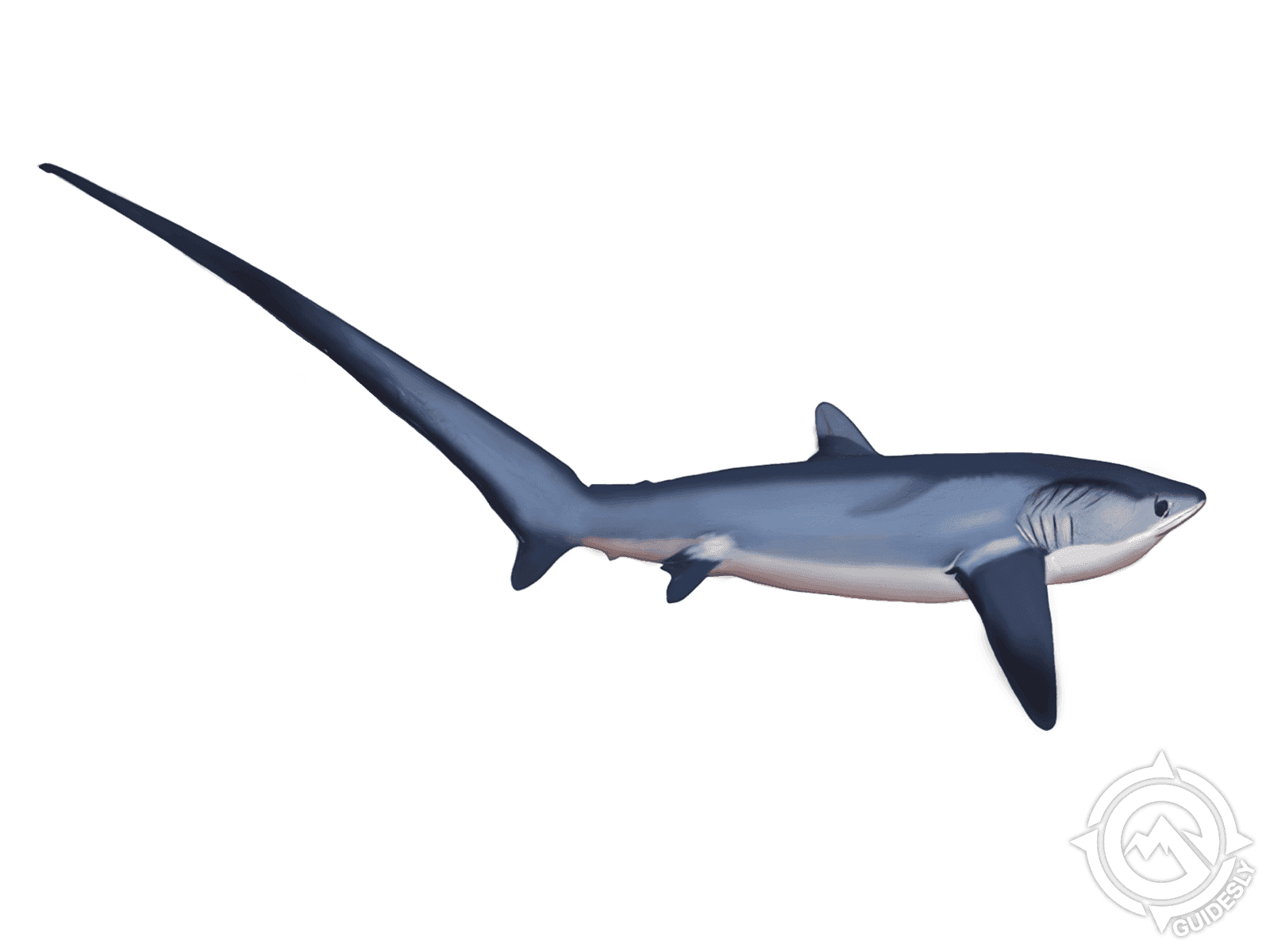Pelagic Thresher

Species Details
Alopias Pelagicus
Alopiidae
Lamniformes
Offshore
55 - 95 lbs.
108" - 144"
Pelagic Thresher (Alopias pelagicus) Fish Description
The Pelagic Thresher (Alopias pelagicus) is a shark known for its exceptionally long tail. From the name alone, one could easily surmise that the shark is mostly found near the surface of the open ocean—specifically in the tropical and subtropical waters of the Indian and Pacific Oceans. Like all members of the thresher shark family (as there are three kinds), the Pelagic Thresher uses its long tail to slap its prey, stunning or sometimes even killing them, thus, easier to catch.
The Pelagic Thresher is often mistaken for the Common Thresher given they both have long tails, grayish to bluish color, fusiform bodies, short heads, cone-shaped noses, small dorsal fins, and large pectoral fins. One way to tell them apart is through their size as the common thresher tends to be a lot bigger than the pelagic kind with their average sizes at around sixteen feet and ten feet respectively. Another way to differentiate the two types of thresher sharks is their choice of habitats with the pelagic mostly opting to stay in the open waters of the Pacific and Indian Oceans, while the common one can pretty much be found anywhere—from the Pacific to the Atlantic, in the open ocean as well near the coasts.
As all sharks are, the Pelagic Thresher is an adept predator. As earlier mentioned, they use their long tails as sort of a whip to stun their prey, which usually consists of smaller fishes that are commonly schooling, particularly herring, flying fishes, and mackerels. When fish is scarce, however, they may opt to eat squids and cuttlefishes as well. They would sometimes even venture near the shores to look for food.
Interesting Facts About the Pelagic Thresher
- The biggest Pelagic Shark ever recorded measures twelve feet long and weighs around one hundred and ninety-five pounds.
- There have been records of sixteen-foot Pelagic Thresher sightings but they are not verified.
- There are three types of thresher sharks with the Pelagic being the smallest.
- They are known to be ovoviviparous—a term used for animals that produce and develop eggs inside their body then would give birth to live ones.
- They have a lifespan of up to sixteen years in the wild.
- Despite their fairly large size and predatory prowess, Pelagic Threshers are known to be timid creatures.
- They are also preyed upon by larger shark species.
- There are no recorded attacks on humans by these timid sharks; in fact, they tend to swim away when they encounter humans.
- They are often targeted by commercial fishers for their meat, fins (which are turned into a soup) and livers (which are harvested for the squalene oil), and skin (which are made into leather.)
- They are often caught as a by-catch by commercial fishers targeting tunas, mackerels, and herring.
- Their populations have been steadily declining in the past few decades because of overfishing—accidental or otherwise.
Size and Swimming Speed
The Pelagic Thresher may be the smallest of the thresher shark species but it can still be quite huge. They can grow more than twelve feet long; although their average size tends to be just around nine to ten feet long. And like most sharks, Pelagic Threshers are fast and strong swimmers thanks to their powerful tails and streamlined bodies.
Habitat and Distribution
The Pelagic Thresher, as the name implies, inhabits the pelagic zone of the open ocean, typically from just beneath the surface of the water to at least 500 feet deep. Although they tend to stay in the open ocean for most of their life, they may also wander near the shores from time to time, especially when the inshore waters are cool or when they're looking for food.
They are found in the offshore waters of the Pacific and Indian Oceans, and sometimes even in the Mediterranean Sea. They are also said to be most abundant off the north-eastern coast of Taiwan. In the US, the coasts of California are said to be fishing hotspots for the Pelagic Thresher.
Pelagic Thresher Fishing Tips
Like with any shark species, the Pelagic Thresher can easily be drawn into your fishing spot by employing chumming. Bloody cut pieces of mackerel, tuna, or any other fish can easily do the job. For bait, whole, strip, live yellowtail snappers, or mullet are said to be the best choice. You can also opt for feathers, lures, or any artificial baits used for catching marlins and tunas. Lastly, all thresher sharks, including the Pelagic kind, would slap the bait using their long tails; so you can expect them to get hooked in the tail. Once hooked, like all sharks, they will put up a good fight—most will even try to leap into your boat—so get ready for a long and exhausting fight if you’re targeting a Pelagic Thresher.







